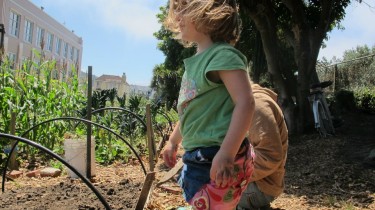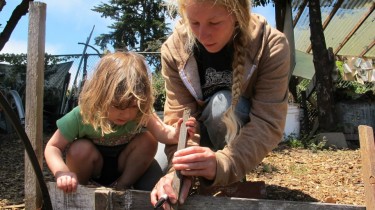“Why try to explain miracles to your kids when you can just have them plant a garden.” Robert Brault
There have been many discussions about childhood obesity and ADHD, and how these concerns are impacted by the amount of technology in the lives of children. These issues are complex and will not be easily resolved. But what is also gaining attention, deservedly, is the role nature plays in a child’s development and their understanding of the world around them.
Few people would dispute that over the last 100 years or so we have made incredible advances in science and technology, and have seen massive improvements in our over-all quality of life. But it hasn’t been all positive. As we’ve moved from an agrarian society to an urban, industrial/post-industrial one, we have lost contact with nature. And with that we have lost our understanding of where our food comes from, how plants and animals live and grow, our role in nature, and how our actions impact the natural world. This lack of connection is becoming a serious problem. And it is especially troubling in the ways it affects children.
Where does our food come from?
 Many children have no idea how a chicken nugget is related to an actual chicken, or how green beans grow. When asked where broccoli comes from, they respond, “from the store!” And it’s not surprising. Most children have never been to a farm. And, sadly, many have never seen a garden filled with vegetables. This lack of exposure to vegetables leads to a lack of food curiosity, and can make children into “picky eaters.”
Many children have no idea how a chicken nugget is related to an actual chicken, or how green beans grow. When asked where broccoli comes from, they respond, “from the store!” And it’s not surprising. Most children have never been to a farm. And, sadly, many have never seen a garden filled with vegetables. This lack of exposure to vegetables leads to a lack of food curiosity, and can make children into “picky eaters.”
The good news is that several studies have shown that simply visiting a garden or farm vastly improves their understanding of how food is grown and can improve their food choices. Just seeing food growing helps to not only increase the likelihood that a child will express a new preference for those vegetables, but also for vegetables they do not see. In other words, just by seeing a bed full of carrots will improve the chances a child will also eat more broccoli.
Curing nature-deficit disorder
There is growing evidence that being outside in nature has a calming effect on children with ADD/ADHD, and there are some who use the term “Nature-Deficient Disorder” to explain how modern life may be contributing to the problem. Much of what is typical in our modern life — television, computers, video games, etc. — requires direct attention, and can be tiring because the brain has to filter out other stimuli to be able to concentrate. This can be draining, and may lead to the inability to focus — “attention fatigue.” Natural settings use a different type of attention, and help feed a child’s level of fascination, which allows their attention to go where it will naturally, which recharges it.
Unfortunately, opportunities for children to get out into nature are dwindling. Indoor technology, while not necessarily a bad thing in and of itself, makes it that much easier for children to stay inside and not experience boredom. Concerns about safety, as well as urban living settings, prevent many children from exploring their natural world as freely as their parents did. There simply are too few opportunities for children to “go outside and play.”
 But the same studies that show the benefits of a natural setting make it clear that even a small view of nature is effective. A patch of green outside a classroom window, a patio garden, or even a flower pot on a stoop helps give a sense of calm, attracts bugs and birds, and can even spark a child’s curiosity and imagination.
But the same studies that show the benefits of a natural setting make it clear that even a small view of nature is effective. A patch of green outside a classroom window, a patio garden, or even a flower pot on a stoop helps give a sense of calm, attracts bugs and birds, and can even spark a child’s curiosity and imagination.
Building confidence
While there are many benefits to visiting a park or looking out a window, children (and adults) need to feel an emotional connection to nature to fully benefit from it. Here’s where having even a small garden helps. The act of gardening can be relaxing, sure. But it’s more than that. It gives the gardener a sense of purpose and accomplishment. In addition to providing a place to explore, gardens can also boost child’s self-esteem, by providing difficult tasks — projects such as mulching, watering, and weeding — to expand their skills, learn responsibility, and build confidence in their abilities.
Gardening with children can be a bit of a challenge, for both the gardener and the children. But the rewards are so incredible you’ll be glad you did.
Photographs by Lily Rothrock.
Karen Price is the social media coordinator for SmartGardener.com, an online app designed to help gardeners to easily plan, grow, manage and harvest their own food. She has an associate teaching degree in early childhood education and is currently pursuing a degree in environmental studies, with an emphasis on outdoor learning experiences and food production.




